Diseases and pests of sweet cherry

Sweet cherry is a thermophilic, whimsical, but at the same time a very grateful culture, the care of which provides not only timely watering, feeding and pruning, but also protection from various pests and pathogens. What diseases are cherries susceptible to? What pests pose a threat to her? How to protect cherries from pests and pathogens?
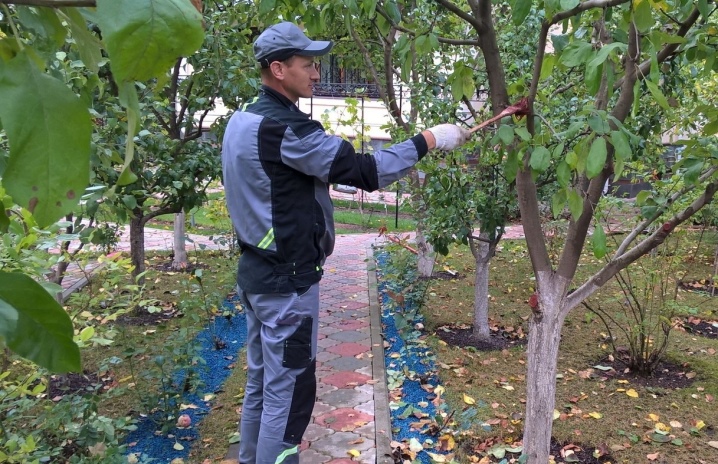
Description of diseases and their treatment
Sweet cherry is considered a rather demanding fruit crop that needs constant and competent care. She is one of the most sensitive garden dwellers, sensitive to cold, temperature changes, exposure to direct sunlight, drought, high humidity and acidity of the soil. Unfavorable weather conditions, as well as irregular or illiterate care of this plant, lead not only to a decrease in yield, but also to a decrease in its immunity. This, in turn, entails a loss or decrease in the ability to withstand attacks by insect pests and pathogens of various diseases.
Depending on the cause and nature of the course, all cherry diseases can be conditionally divided into several categories – infectious (fungal, bacterial, viral) and non-infectious (for example, developed after mechanical, chemical or thermal injuries or as a result of a massive attack of insect pests and damage caused by them). It should be noted that each category of diseases provides for its own plan and method of treatment, the use of certain drugs and folk remedies.
Therefore, an important condition that determines the success of further treatment of sweet cherry is the accurate and timely determination of the cause of the disease.
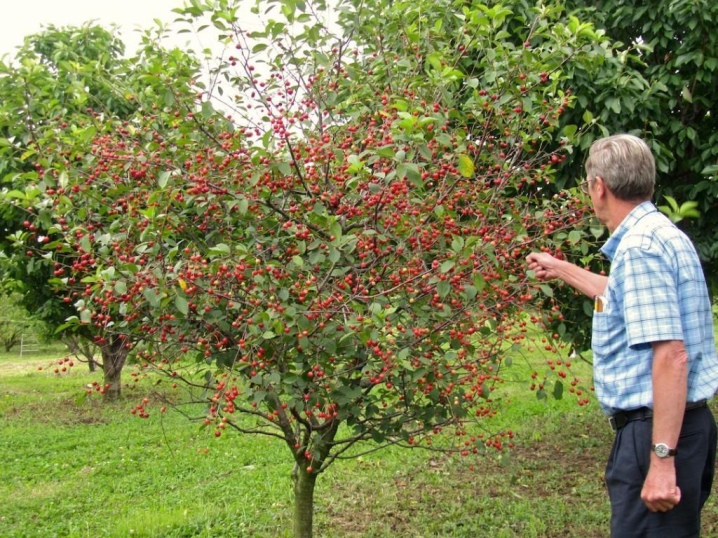
Fungal
This category of cherry diseases is caused by pathogenic fungi (fungi) - lower organisms that easily adapt to new and unknown habitats and rapidly form huge colonies. The most common fungal diseases of sweet cherry are presented below.
- Powdery mildew - a fungal disease, the main symptom of which is the formation of a dirty gray plaque on the branches, trunk, leaves, ovaries and fruits of the tree. The progression of the disease leads to a lag in cherry growth and development, a drop in its yield, and a decrease in immunity. The leaves of the tree affected by the fungus curl, turn yellow and gradually die off.
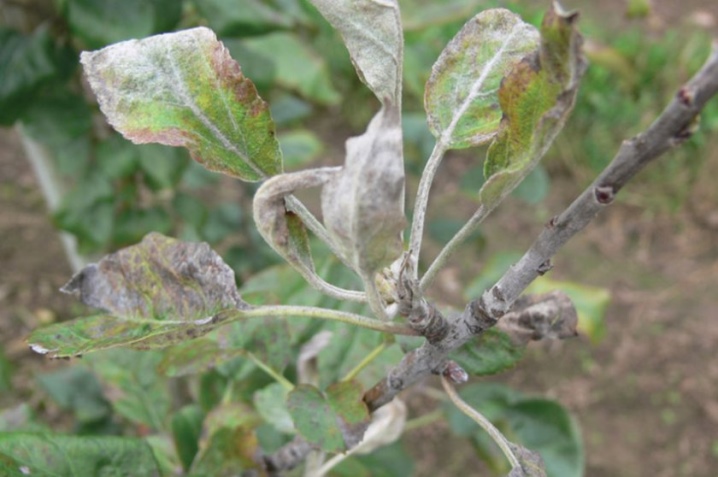
- Clasterosporium disease - a dangerous disease, otherwise called "perforated spot". A characteristic symptom of this disease is the formation of small (up to 2 mm) specks of gray-brown, red-brown, purple-red or crimson color on the leaves of the tree. Within a few days, the spots reach a size of 3-6 mm, turn pale and crack in the central part. After that, a through hole (hole) with a red or dark purple border is formed in place of the spot. The presence of a border around the edges of the holes is an important specific feature characteristic of this particular disease. As the disease progresses, ulceration appears not only on the leaves, shoots and trunk of the tree, but also on its fruits. If untreated, cherries affected by clasterosporiosis noticeably lag behind in growth and lose their potential yield. In cases of severe damage, the tree dies.

- Coccomycosis - another insidious fungal infection, a characteristic symptom of which is the formation of small (up to 2-3 mm) red-brown or brown spots on the leaves of sweet cherry. Over the course of several weeks, their number increases rapidly, as a result of which they begin to merge with each other, forming large marks of various shapes. When examining the affected leaves from the underside, traces of pinkish or dirty gray fluffy plaque (mycelium) are revealed. If untreated, cherry leaves curl and fall off. The ripe fruits of the affected tree have an unattractive dirty brown color, a watery taste, and an ugly shape. Often, there are traces of rot and mold on the berries.
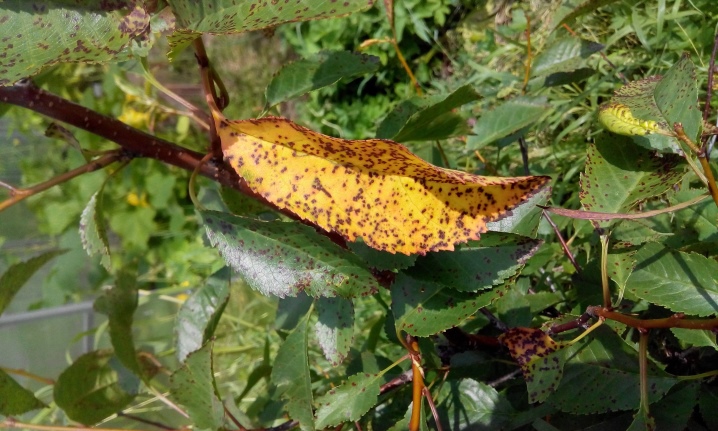
- Moniliosis - a severe fungal disease that can lead to the death of cherries. Typical signs of culture damage by this disease are yellowing and death of foliage, drying and blackening of branches, mummification of fruits. Infection occurs by the penetration of the causative agent of the disease (fungus) through the pistils of flowers into the forming ovaries. In addition, the pathogen is capable of infecting trees by penetrating through the buds.
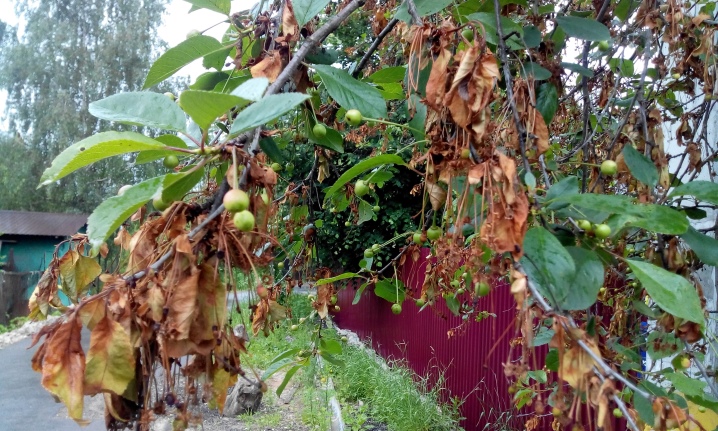
- Verticillosis - a dangerous fungal infection that causes desiccation and death of cherries. In the acute course of the disease, the death of the tree occurs within 9-10 days, in the chronic course - within several years. The first signs of verticillium damage to plants are twisting, drying and yellowing of leaves in the lower parts and at the base of the branches. Gradually, the disease spreads to young growth, also causing curling and drying of the foliage. Often, the affected trees give a bountiful harvest, but the berries have a very poor taste. When cutting the bark of an affected tree, you can smell the sour smell of fermented tissue sap.
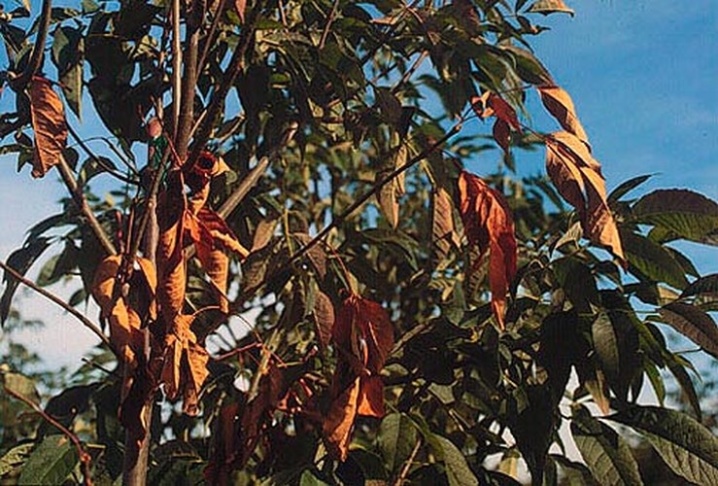
A very dense arrangement of trees in the garden, high air humidity, lack of light often become the reasons for the appearance on the trunks and branches of the cherry with a moldy bloom of a dirty gray, gray-green or reddish-brown color.
The source of the problem is a fungus whose colonies quickly spread throughout the tree. Active reproduction of fungal colonies leads to a decrease in sweet cherry immunity, a decrease in its yield, and mold damage to fruits.
The main means of combating the above diseases of sweet cherry are fungicidal preparations that destroy the fungus. Most often gardeners use the following fungicides:
- "Abiga Peak" - contact fungicide based on copper, which destroys most types of fungal infections;

- "Alirin-B" - a fungicide that destroys the fungus and suppresses the development of its colonies both on plants and in the soil;
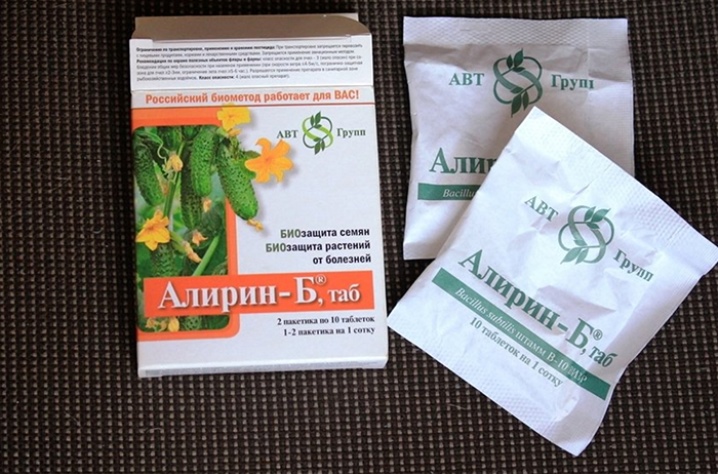
- bordeaux mix - an effective broad-spectrum contact fungicide;
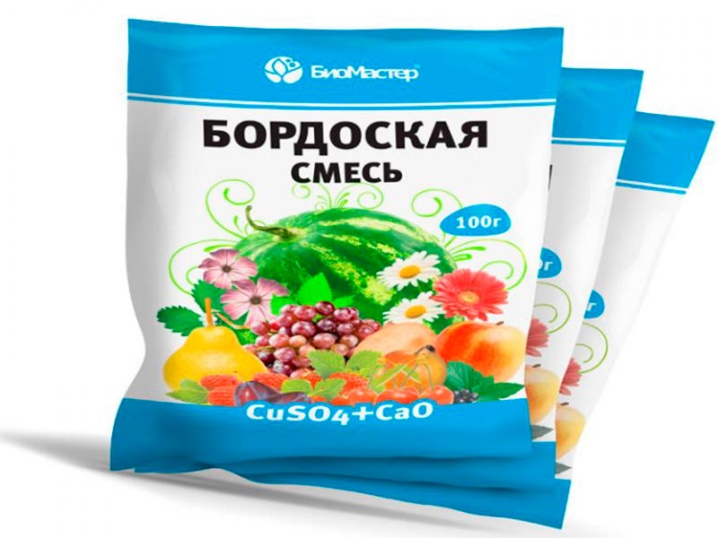
- copper sulfate - a fungicide most often used in the treatment of fungal infections of fruit crops;

- "Strobe" - a powerful local-systemic fungicidal drug used in the treatment of various fungal infections;
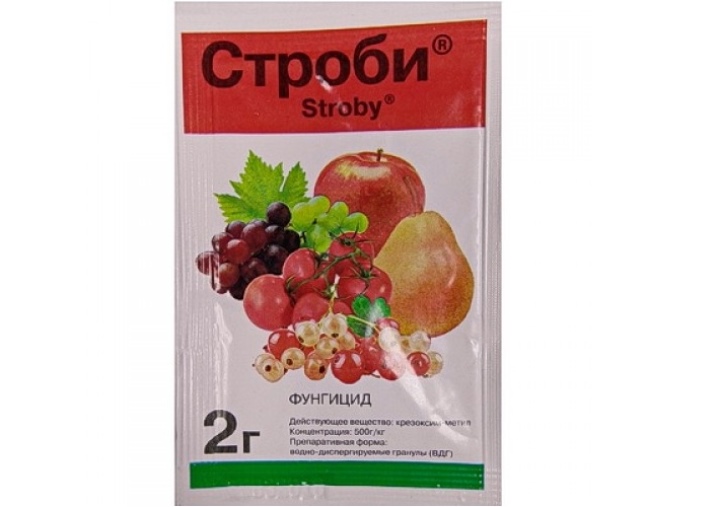
- Topsin-M - a fungicidal drug that has a systemic toxic effect on most types of fungi;
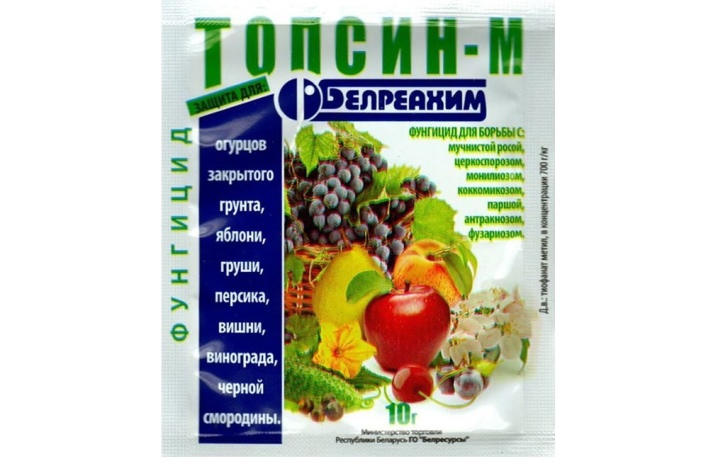
- "Fitosporin-M" - biofungicide, providing contact antifungal and antibacterial action;
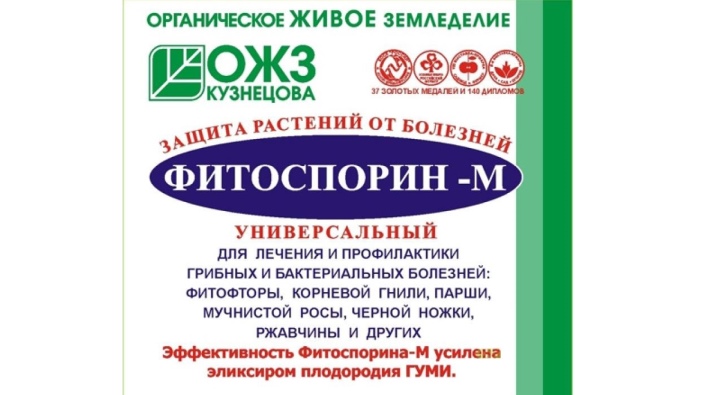
- "Horus" - a fungicidal preparation used to combat moniliosis, rot, scab of fruit crops.
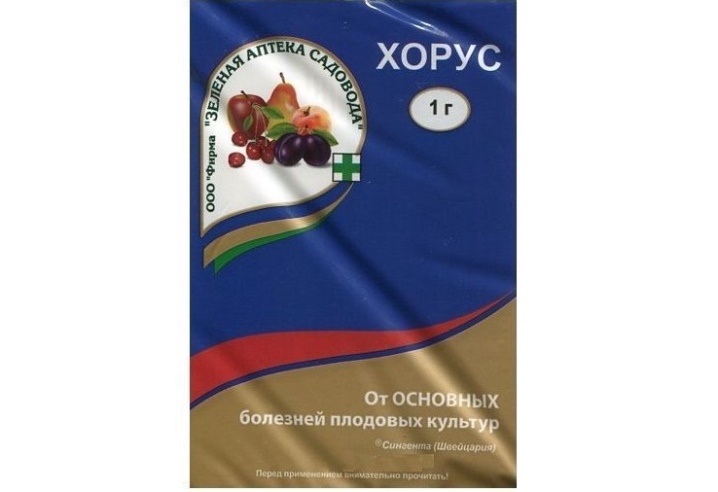
The presented preparations are used for spraying affected trees. Cherry should be treated with chemistry only before the flowering period or 2-3 weeks after the end of fruiting.
The number and frequency of treatments required to cure cherries depends on the characteristics of the agent used, the type of fungal infection and the extent to which it affects the trees in the garden.
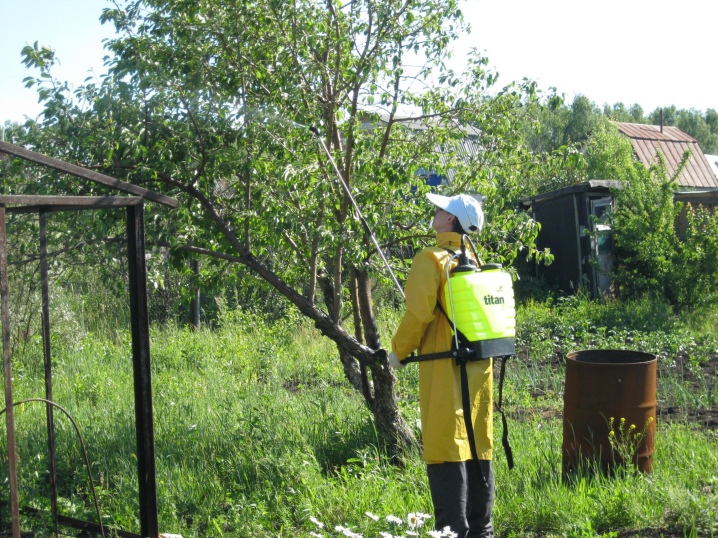
Bacterial
The causative agents of diseases of this group are pathogenic microbes, which most often attack weakened and relatively young trees at the age of 3-8 years.Harmful bacteria are spread by insects, wind, precipitation. To a large extent, the risk of bacterial infection of sweet cherries increases if there are diseased trees in neighboring areas.
Bacteriosis is a serious bacterial disease that poses a serious danger to many horticultural and horticultural crops. When cherries are affected by this disease, ulcers begin to form on the branches, oozing gum, which is a viscous and sticky substance similar to an amber resin. As the disease progresses on the affected branches, the leaves wrap around the edges and dry out. Along with this, the bark also blackens and dies. On the buds of the tree and the stalks of ripening berries with bacteriosis, the formation of small ulcerations is noted.
The danger of bacteriosis for fruit crops lies in the absence of effective methods and means of treatment. The affected parts of the plants must be removed and destroyed, and the cut sites must be treated with garden varieties. It is worth noting that plants that receive nitrogen-containing fertilizers in a timely manner and regular, but very moderate watering, demonstrate the greatest resistance to this disease.
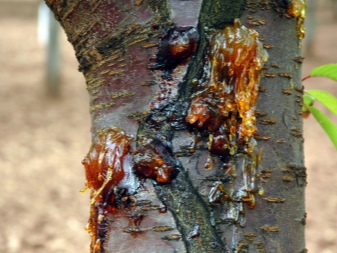
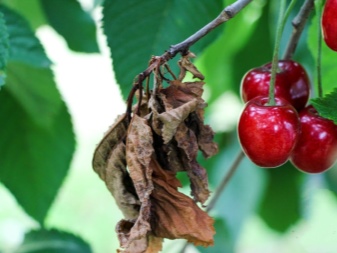
Viral
Diseases of this category are caused by harmful viruses that penetrate all parts of the plant. The main danger of viral infections is that it is extremely difficult to fight them both with the help of aggressive chemicals and with the help of folk remedies. In fact, there are no effective remedies and methods for viruses that attack fruit crops.
In most cases, gardeners have to uproot and destroy the affected trees to keep the entire garden from becoming infected.
- Mosaic disease (mosaic, mosaic ringing) - a viral infection, most often affecting weakened fruit crops. After infection, pale yellow marks are formed on the leaves of the affected cherry, localized along the leaf veins. As the disease progresses, the leaves on the affected trees curl, acquire a dirty brown hue, dry out and fall off. Since the disease does not respond to any treatment, the infected tree is uprooted and destroyed.
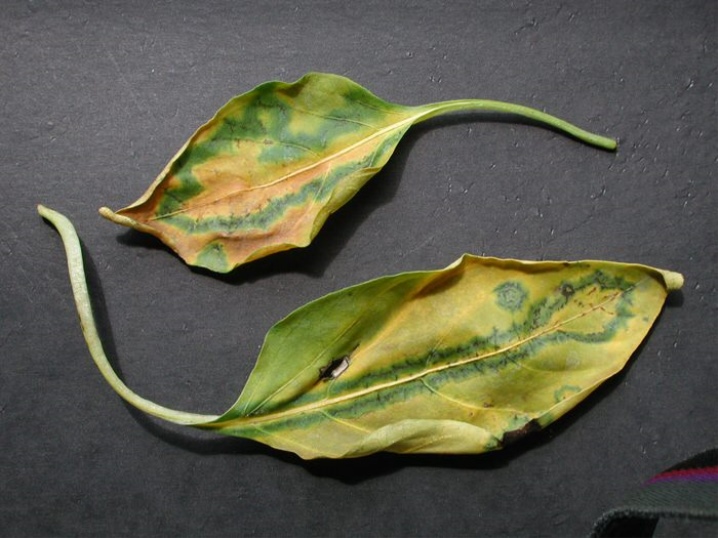
- Cherry Leaf Rasp Virus - a viral disease, the main region of distribution of which is North America. When infected with this virus, specific growths are formed on the lower surface of the cherry leaves, while the leaves themselves are deformed and bent. Along with this, the yield of the fruit crop decreases, the taste of berries is significantly deteriorated. Young plants infected with this virus usually die. The main vector of the disease is the American nematode, closely related species of which are found on the territory of Russia.
For this reason, domestic experts do not exclude the risk of infection with the rasp virus of the leaves of fruit trees growing in the horticultural regions of the Russian Federation.
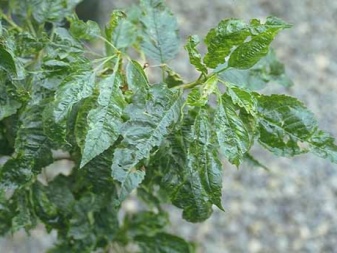

- Leaf roll virus Is another dangerous viral disease that poses a threat to many cultivated plants - sweet cherry, cherry, walnut, dogwood, elderberry. In a plant infected with this virus, leaves begin to curl, turn yellow and dry out. At the same time, the growth and development of the tree slows down, its appearance and general condition deteriorate significantly. In the future, the affected plant dies. There is no effective treatment for this infection, as in previous cases.
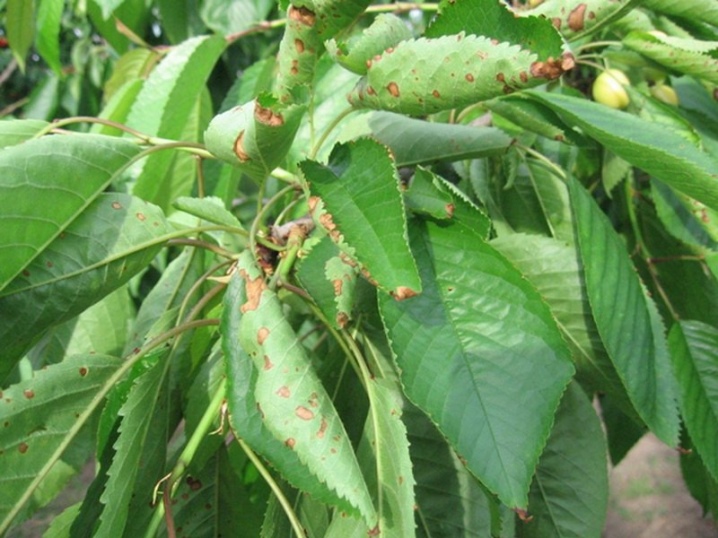
Non-infectious
This category of diseases usually develops as a result of trauma and damage to cherries caused by various factors. This category also includes the deterioration of the condition of fruit trees, a decrease in their immunity and a decrease in yield due to unfavorable weather conditions and violations of agricultural cultivation techniques.
Hommosis or gum flow is a pathological condition that occurs in many woody plants. This condition is characterized by cracking of the tree bark and the subsequent release from the cracks of a viscous translucent substance that hardens in air (gum). This problem can arise due to mechanical damage to cherries - for example, with frost cracks formed under the influence of low temperatures. Often, gommosis develops in fruit trees under the influence of unfavorable environmental factors. - high temperature and humidity, excess fertilizers, high acidity or waterlogged soil.
Other factors causing the development of gommosis in cherries: active activity of insect pests and pathogens (fungi, bacteria).
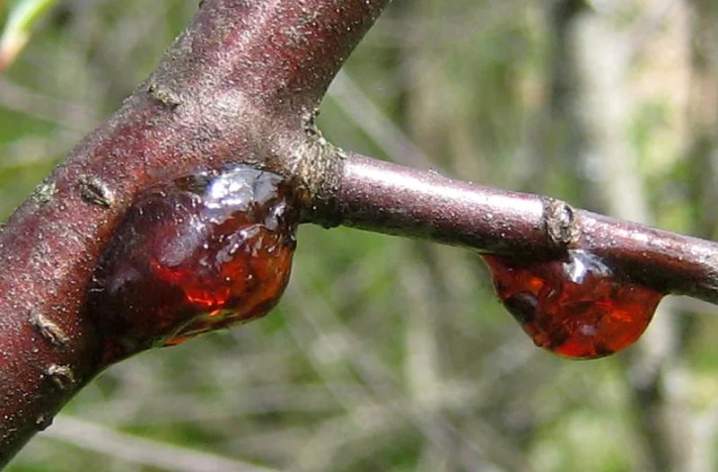
Before treating the affected tree, the cause of the appearance of gommosis should be accurately determined. If the problem is caused by a fungal or bacterial infection, it is required to take all the necessary and possible therapeutic measures - removal of the affected leaves and branches, treatment with appropriate drugs. If gommosis has arisen as a result of an increased potassium content in the soil, calcium or calcium-containing fertilizers should be applied. Being an antagonist of potassium, calcium neutralizes its action, and the problem of cherry gommosis will be solved.
Do the following with damage to the branches and trunk:
- treat the damage with a fungicidal or antibacterial agent (a 1% solution of copper sulfate is suitable);
- a special putty containing antibacterial components is applied to the treated wound (for example, from nigrol and ash in a ratio of 7: 3).
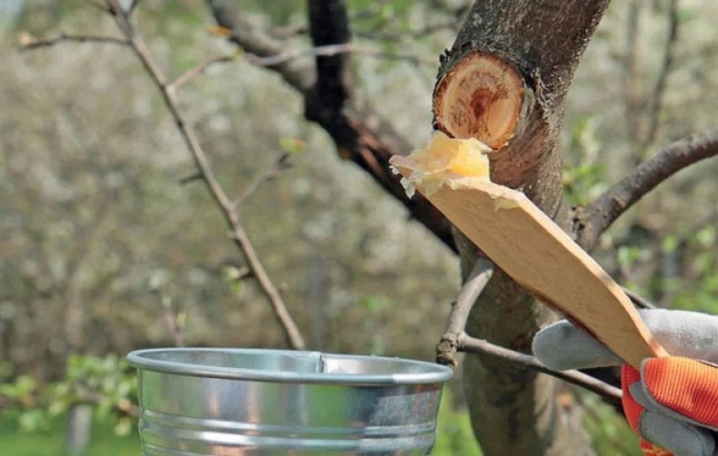
Furrowing gives good results in the fight against gommosis. It is carried out by cutting the bark on the branches almost to the wood (the cuts are made along the branch). In addition, the bark is additionally incised on the trunk, circling it with a sharp knife. This technique allows you to reduce the concentration of tree sap in cherries and thereby prevent the formation of new breaks and cracks.
In addition to the above methods of combating gum flow, at the beginning of winter, trees that have entered the dormant phase are treated with a 3% solution of copper sulfate. It can also be carried out in early spring during the period of swelling (but not opening!) Of the buds, using a 1% solution of copper sulfate.
This procedure will allow not only to improve the health of the tree as a whole, but also to protect it from pathogenic bacteria and fungi.
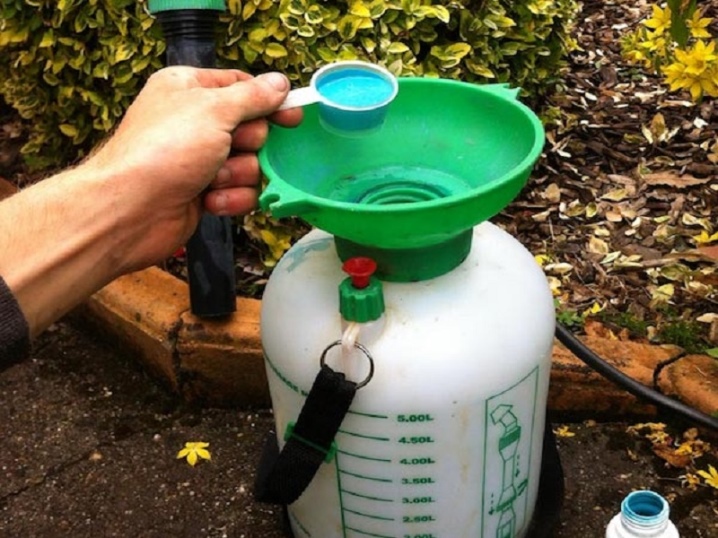
Pests and the fight against them
Withering of cherries, deformation of its leaves and berries, decreased yield, yellowing and shedding of leaves - important symptoms, often indicating the defeat of the crop by insect pests. In some cases, to accurately determine the type of pest, it is sufficient to carefully examine the most affected parts of the plant (sections of the trunk, the surface of branches, leaves, the surface and the inside of the fruit), using a magnifying glass if necessary. With this simple tool, you can find both adult insect pests of sweet cherries and their larvae and even clutches of eggs.
The garden aphid is a small sucking pest of sweet cherry and many other fruit crops, feeding on the cell sap of plants. Adults on cherries can most often be found in early or mid-summer by carefully examining the lower parts of the leaves of the affected trees.
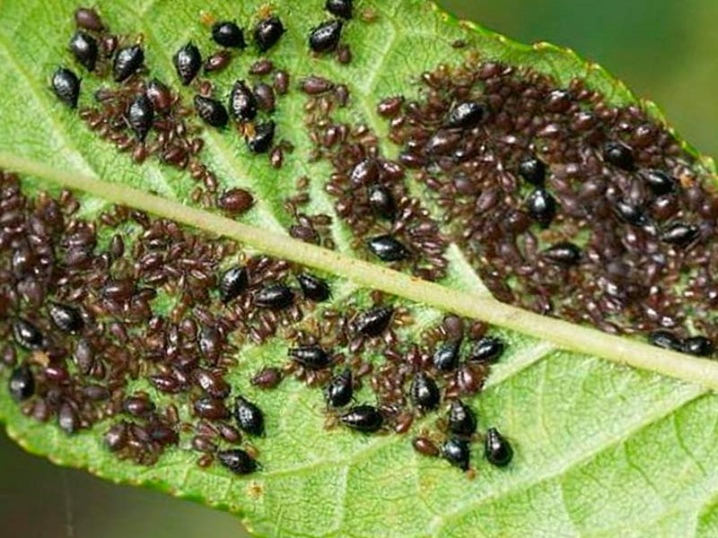
The main signs of aphid damage to garden trees are:
- clusters of colonies of small black insects (less often gray or green) on the underside of leaves, on buds, flowers and ovaries;
- spiral twisting, wrinkling of leaves and their drying;
- a stop in the development and growth of buds, ovaries and forming berries;
- the presence of a large number of ants on the trees (or under them).
In most cases, the aphids get to the site during the migration of ants, which are attracted by the honeydew secreted by it - a sticky substance containing a large amount of sugars. Moving from one territory to another, ants carry aphid colonies with them.For this reason, while carrying out the fight against aphids, the gardener must simultaneously control the number of ants on the site. You can get rid of them in the following ways:
- remove all anthills from the garden;
- scatter bleach in the tree trunks;
- wrap tree trunks with "trapping belts".
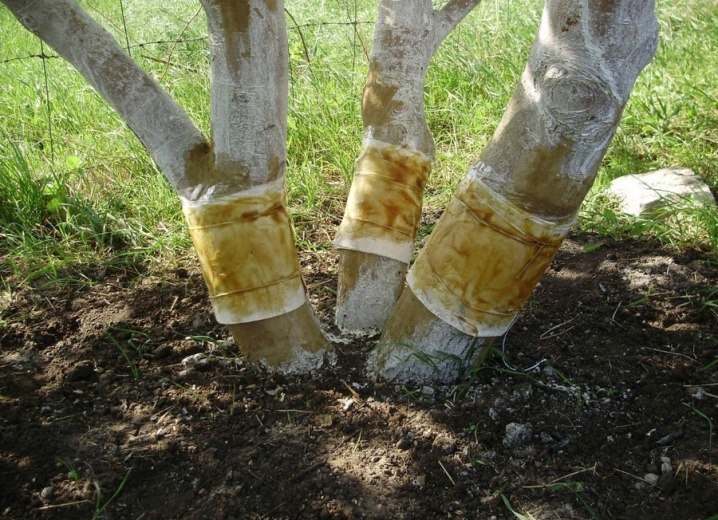
To combat aphids, insecticides are used: "Inta-Vir", "Decis Profi", "Aktara", "Biotlin", "Commander". They are used, strictly observing the consumption rates, timing and frequency of treatments of the affected sweet cherry. During flowering, drugs are not used so as not to harm bees and other pollinating insects.
Additionally, trees affected by aphids are sprayed with a solution of ammonia (2 tablespoons of ammonia and 1 tablespoon of liquid soap in a bucket of water) or a soap and soda solution (2 tablespoons of soda, 1 tablespoon of soap, 1 liter of water ).
Cherry fly is another malicious pest of fruit crops - sweet cherry, cherry, apricot, barberry. It is a small (4-5 mm) black front sight with translucent black and white wings. The pest is most active after cherry blossoms - during this period it lays eggs in the set fruit. From the eggs laid, larvae soon appear - small white-yellow worms that eat the flesh of the fruit.
Cherry berries affected by cherry fly larvae are not eaten or used for culinary purposes.
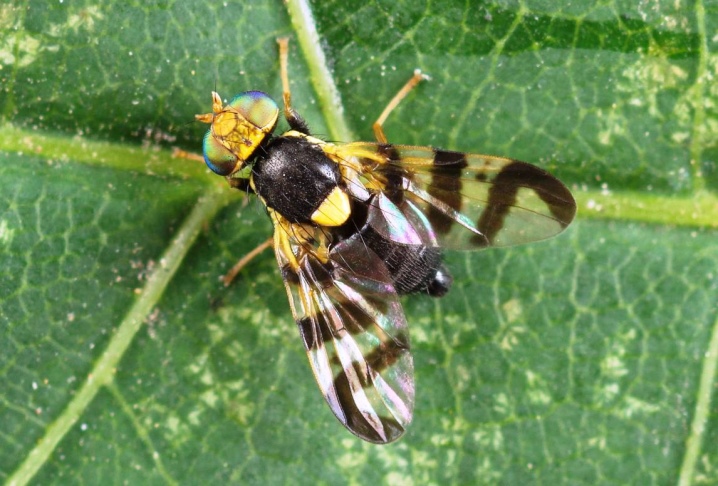
To combat the pest, insecticides are used: "Fufanon", "Inta-Vir", "Iskra", "Confidor". It is recommended to use them about 10 days after the fly leaves the soil (larvae pupate in the ground). Trees should be re-treated in 13-14 days.
Good results are obtained by treating trees with "Lepidocide" - a biological product with a less aggressive action. It is recommended to use it during bud formation and after cherry blossoms.
The cherry leaf beetle is an aggressive pest that damages the ovaries and leaves of sweet cherry and other fruit crops. It is a small beetle 5-7 mm in size (there are also larger individuals - up to 8-9 mm) of black or dark blue color. The pest is most active in May. To combat the leaf beetle, insecticides of a wide spectrum of action are used - "Fufanon", "Kemifos". Garden processing is carried out during the growing season.
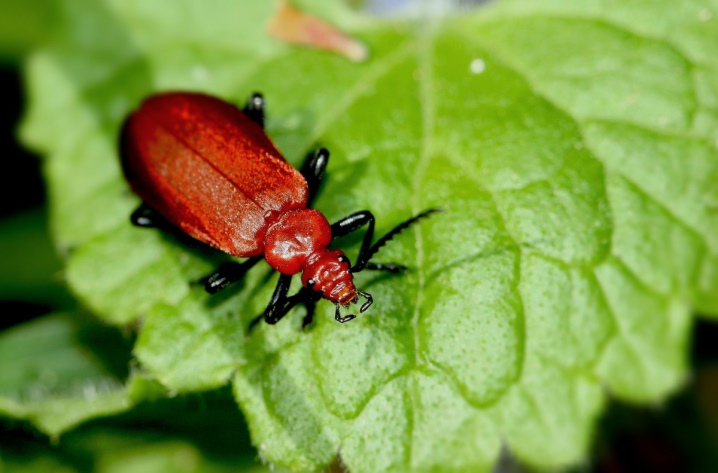
Prevention measures
One of the main measures for the prevention of diseases and damage to cherries by pests is compliance with all recommendations for tree care. Illiterate or irregular care is one of the factors that cause a decrease in the immunity of sweet cherry and its resistance to pathogens and pest attacks.
Agrotechnical measures that a gardener should regularly carry out when caring for cherries are:
- timely cleaning of foliage, plant debris and weeds, which can become a shelter for pests and pathogens;
- compliance with the irrigation regime in accordance with weather conditions;
- control of soil acidity in the garden;
- treatment of trunks with whitewashing in the fall, allowing to prevent the formation of frost cracks.
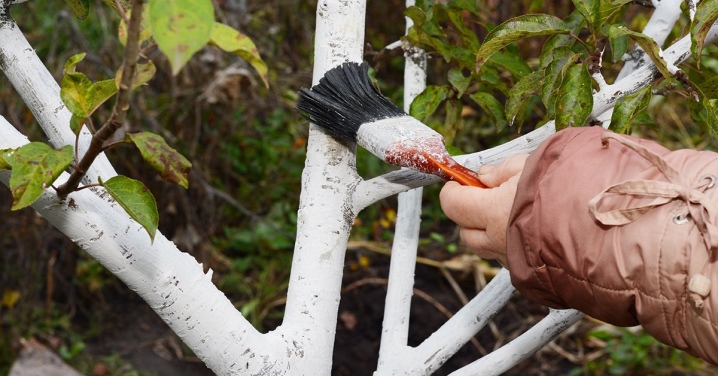
To strengthen the immunity of sweet cherry and protect it from diseases and insect pests, preventive autumn processing of the tree with a 5% urea solution allows. It is recommended to spray not only trees, but also the surface of the ground in the trunk circle.
After harvesting, remove all the sweet cherries in the garden. The fallen berry not only attracts pests to the garden, but also creates a favorable environment for the reproduction of fungi and bacteria.
Any damage to the branches and trunk of the cherry (cracks, cuts, sunburn, breaks in the bark, wounds caused by rodents) must be treated in a timely manner. For processing, a 1% solution of copper sulfate and a 3% solution of ferrous sulfate are used. Then the damage is covered with garden pitch.
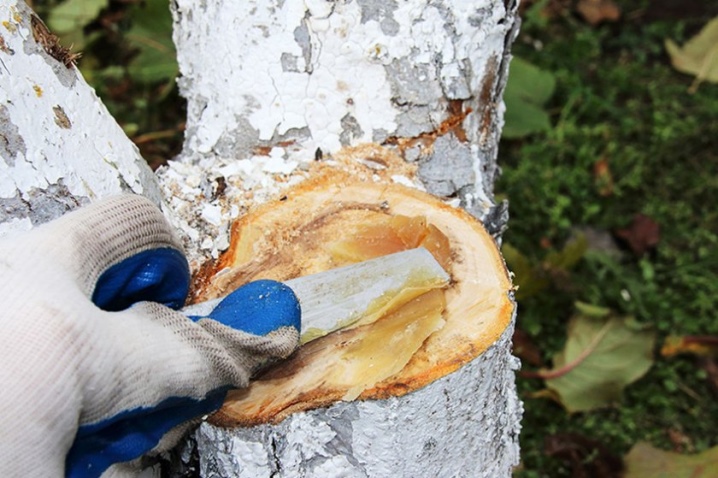
In order to prevent diseases of cherries, it is recommended to carry out periodic preventive treatments of the garden with a solution of iodine and soap. (10 l of water, 10 ml of iodine, a small amount of liquid soap). Good results are also obtained by periodically spraying trees with water with the addition of a small amount of iodine and potassium permanganate. Such spraying is carried out several times per season. Iodine and potassium permanganate, possessing a powerful antiseptic effect, suppress the activity of pathogens and thereby reduce the risk of developing diseases in cherries.
Experienced gardeners recommend purchasing disease-resistant cherry varieties for growing. These are such cold-hardy and fruitful varieties as Bryanskaya rozovaya, Raditsa, Revna, Tyutchevka. Seedlings should be purchased only in specialized gardening stores to avoid the likelihood of buying sick or pest-infected planting material.














And my fruits just dry up and fall off. I remove the leaves with aphids. In the spring I spray it with Bordeaux liquid. From the ants I sprinkle the lower part of the trunk and the ground with "Fas-take 2" powder, on the trunks - hunting belts. In the fall, I whitewash the trunks. I water it almost every day. I live in Volgograd. I really want to try my cherries, but I can't!
Cherries should not be watered often. Water 4-6 times per season: the first time - before flowering, the second - after harvesting, then focus on weather conditions.
Anatoly, the best remedy for ants is the Great Warrior granules. He himself suffered for several years. Tried everything. And only "Warrior" helped to defeat them. All the pleasure is 30-50 rubles. per pack.
Do you water it often?
We live in the Voronezh region. The sweet cherry was planted two years ago, this year it bloomed, but they did not rejoice for long, someone began to eat the leaves, the top was all eaten.
I live in the Moscow region. This year, cherries had very few leaves on the lower branches, but there were a lot of flowers, there were also a lot of berries, and now the berries are all crumbling, and the leaves began to dry and fall off, and this is only on the lower branches.
I live in Kaliningrad. 3 years ago we planted 2 cherry trees. Fruits have appeared this year: large, beautiful berries. In the evening I watered it - everything was fine, and the next day I went to look at it: there was nothing left on one tree, no berries. In places there are sticks with bones. Who could gnaw like that? What kind of beetles or birds? They even ate the pink berries. I wanted to taste what we were growing ourselves.
These are birds. For the second year I have been eating this way. This year I saw how it happens. Connoisseurs advised to cover with a net. We will try it next year.
The comment was sent successfully.